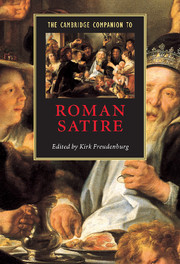Book contents
- Frontmatter
- Introduction
- Part I Satire as literature
- Part II Satire as social discourse
- 10 Satire as aristocratic play
- 11 Satire in a ritual context
- 12 Satire and the poet
- 13 The libidinal rhetoric of satire
- Part III Beyond Rome
- Conclusion
- Key dates for the study of Roman satire
- Bibliography
- Index
- Series list
10 - Satire as aristocratic play
from Part II - Satire as social discourse
Published online by Cambridge University Press: 28 May 2006
- Frontmatter
- Introduction
- Part I Satire as literature
- Part II Satire as social discourse
- 10 Satire as aristocratic play
- 11 Satire in a ritual context
- 12 Satire and the poet
- 13 The libidinal rhetoric of satire
- Part III Beyond Rome
- Conclusion
- Key dates for the study of Roman satire
- Bibliography
- Index
- Series list
Summary
Roman satire describes itself as play more often than it describes itself as satire. Its playfulness consists in part of its relationship to other, ostensibly more serious, literary genres (e.g. epic, oratory, history). But in several instances Roman authors link satire with play of a non-literary sort. Thus we may regard the ancient representation of satire as play as an invitation to consider satire as a social practice as well as a literary genre. Satire, like all ancient literary genres, belongs to the history of practices as well as to the history of texts: this would be clear even without references to play. But play - its meaning, variants, and social functions - provides us with a useful means of situating satire among the practices that can be reconstructed from the largely textual remains of ancient Roman culture. Such an endeavor is valuable both as an interpretation of textual references to play (i.e. as an aspect of the so-called “literary” study of satire) and as part of the related enterprise of cultural history, which requires consideration of embodied practices, as well as of more readily accessible texts.
- Type
- Chapter
- Information
- The Cambridge Companion to Roman Satire , pp. 177 - 191Publisher: Cambridge University PressPrint publication year: 2005
- 4
- Cited by

